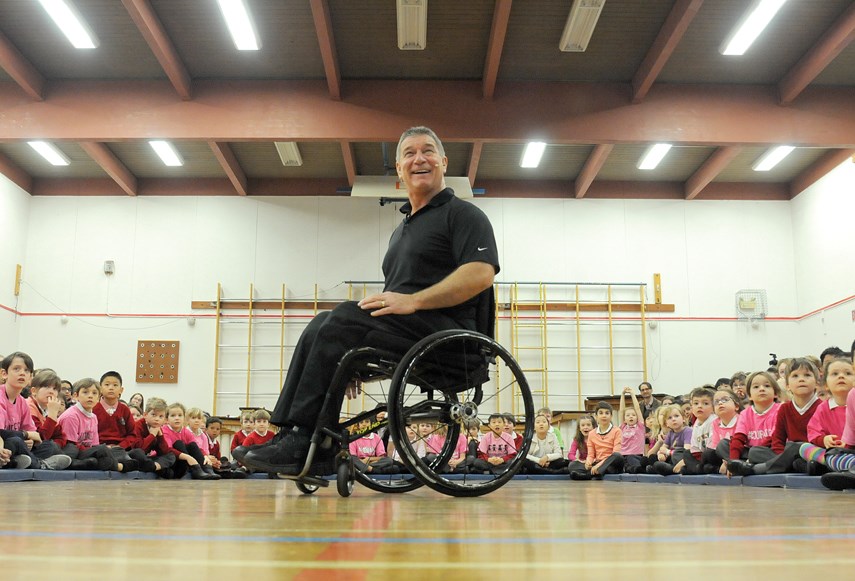In a few minutes, Rick Hansen will roll into Brockton School’s gymnasium.
The students are waiting there, of course, but the place is also teaming with teachers and parents – many of whom remember three decades back when Hansen gutted and grinned his way through nearly three dozen countries and 40,000 kilometres of Great Wall and bad road. Kids who came of age in the mid-1980s might not have understood the importance of spinal cord research but they knew Hansen: “That’s the guy who went around the world in a wheelchair!”
It’s maybe why the parents in Brockton’s gym seem as anxious as the students.
Hansen is in Brockton’s music room, shaking hands and exchanging laughs with a small group of students.
When he gets out there he’ll talk about goals and dreams. His headset fits snugly. He shares a memory. He does a wheelie. He’s told most of these stories before.
In his book, Rick Hansen: Man in Motion; written by Hansen and Jim Taylor, he describes the convoluted circumstances that led to his paralysis. If only he’d opted to go to a volleyball camp instead of a fishing trip with his buddies. If only his friend hadn’t decided to head back in the middle of the night. If only he hadn’t turned down a ride when their truck got stuck.
“What if can drive you crazy, if you let it,” Hansen writes.
But in the gym Hansen keeps the story short. He was hitchhiking home when he got in the back of a pickup truck with a driver who’d been drinking beer. The crash threw him against the ground and broke his back.
“I was pretty sad and frustrated. I didn’t know what life would be like in a wheelchair.”
His speech is about what life is like in that wheelchair but it’s also about life, about goals and dreams.
Now 60 years old, Hansen’s goal is to make Canada more inclusive and accessible.
The Man in Motion tour raised $26 million for spinal cord research. The mindset was generally different in the 1980s, Hansen explains.
“When I did the Man in Motion tour it was largely an area of charitable concern for Canadian society,” he says.
People with disabilities were to be pitied, he explains. “Poor them.”
That thinking evolved into a discussion on human rights and the importance of offering equal treatment in a civil society.
Today, the conversation needs to be on a different plateau, Hansen explains.
It’s still about human rights, but it’s also about money.
“People are realizing that this is not only a charitable and a human rights issue, it’s an economic imperative.”
Building anything that excludes a portion of the population is bad business, Hansen argues.
“Half of our human rights lawsuits are about accessibility,” he says, noting the prohibitive cost of a retrofit solution for an inaccessible building.
As a country Canada needs to consider the rising number of baby boomers coping with mobility challenges as well as the financial costs of having a portion of the population who are unable to work because they can’t get around.
“You add all that up, then you add up the unemployment rates, the social welfare costs in lost productivity,” Hansen says. “This is a huge opportunity that we can’t afford not to take advantage of.”
To bolster his argument, Hansen quotes figures from the Conference Board of Canada, a not-for-profit research organization. Nearly half of Canadians with physical disabilities who are working believe they would be putting in more hours if workplaces were more accessible, according to the Conference Board of Canada. Approximately 57 per cent of unemployed Canadians with disabilities believe they would be working if workplaces were more accessible.
If those improvements were made, approximately 500,000 Canadians with disabilities would start working or work more hours, adding $16.8 billion to Canada’s gross domestic product, according to the Conference Board of Canada.
“We haven’t urgently addressed this based on the DNA of the Canada we want and also the economic imperative,” Hansen says.
Asked about the accessibility of the North Shore, Hansen explains that at the moment, no one can really answer because there are no empirical measurements for accessibility.
There needs to be a national and eventually an international standard for accessibility, similar to the way building codes are rated based on energy efficiency.
Hansen is raising money for an Accessibility Certification Program through the Rick Hansen Foundation. He’s also asking for building owners to reach out to his foundation for an accessibility rating.
“There’ll be no criticisms as to where you are, it’s only the ability to create a framework of where you need to go.”
It’s almost time to go out and address the crowd.
Hansen is prepared to talk about his past but he says he believes his best work is still in front of him.
It’s difficult to grasp how much Canada has changed since Hansen set out on his tour, and how much he’s changed it.
Just before the first leg of the Man in Motion tour, Hansen was slated to be honoured at UBC’s faculty club.
With no wheelchair access, they’d loaded the soon-to-be world famous Canadian icon into a dumbwaiter, cranking him to the wrong floor where, according to the book, he’d scared “the daylights” out of a cook before emerging at the correct floor.
At Brockton, Hansen is introduced by Josh Handford, a student, musician and composer, who’s also visually impaired.
“As someone who lives with a disability but is not defined by it, it’s my pleasure to welcome Rick Hansen and his team to Brockton!” Handford announces.
The crowd cheers and Hansen rolls in.



